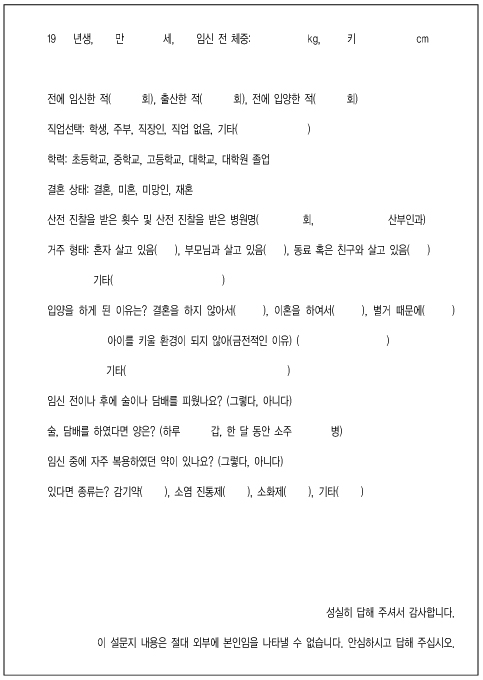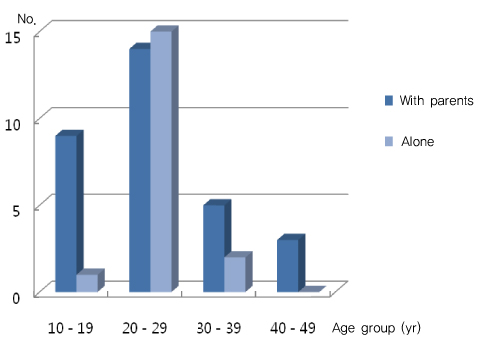Korean J Obstet Gynecol.
2011 Jan;54(1):11-16. 10.5468/KJOG.2011.54.1.11.
Clinical characteristics of pregnant women planning for adoption
- Affiliations
-
- 1Department of Obstetrics and Gynecology, Soonchunhyang University Bucheon Hospital, Soonchunhyang University College of Medicine, Bucheon, Korea. hhl22@schmc.ac.kr
- KMID: 2274017
- DOI: http://doi.org/10.5468/KJOG.2011.54.1.11
Abstract
OBJECTIVE
To determine the necessary management of pregnant women planning for adoption based on general characteristics, problems, and social and obstetric factors.
METHODS
Fifty-seven pregnant women who were anticipated to have a baby adopted were recruited from the department of obstetrics and gynecology of a university hospital between February 2002 and April 2009. These differences among variables were determined using SPSS 12.OK. We calculated the correlations between the pregnant woman's age, height and weight, abortion, the newborn's weight, and social factors.
RESULTS
The mean age was 24.6+/-7.3 years (range, 13 to 42 years). Women in their 20s comprised 57.9% of the participants. The cesarean section rate in unmarried mothers was statistically lower than married mothers. The repeat adoption rate was 17.5%.
CONCLUSION
It is necessary to implement a team approach with the social system and obstetricians to manage pregnant women planning to adopt similar to the prenatal care available for pregnant women planning to keep their newborns.
Keyword
MeSH Terms
Figure
Reference
-
1. Koo JH. A study on models for the child welfare services in local community improvement [dissertation]. 2007. Cheongyang (KR): Korea International Culture Univ..2. Kim HJ, Son JA, Kim JY, Ahn DH. Changing social background pattern of children in adoption institutions (the 4th report). J Korean Pediatr Soc. 1999. 42:115–121.3. Byon MS. A study on the unmarried mothers' social problems and their welfare improvement [dissertation]. 2001. Seoul (KR): Dankook Univ..4. Park KA, Kim SC, Ahn BJ, Ryoo HC. Childbirth teenage. Korean J Obstet Gynecol. 1975. 18:923–928.5. Kang MS, Lee JY, Lee SH, Oh EH, Lee CW, Choi B, et al. The obstetrical and statistical aspects of the unmarried mother. Korean J Obstet Gynecol. 2002. 45:1347–1353.6. Joo SH, Jung Dw, Beak JY, Lee JY, Sohn IS, Kim SY, et al. A study on pregnancy and social welfare of unmarried mother. Korean J Obstet Gynecol. 2005. 48:1760–1766.7. Jadva V, Badger S, Morrissette M, Golombok S. 'Mom by choice, single by life's circumstance...' Findings from a large scale survey of the experiences of single mothers by choice. Hum Fertil (Camb). 2009. 12:175–184.8. Chhabra S, Palaparthy S, Mishra S. Social issues around advanced unwanted pregnancies in rural single women. J Obstet Gynaecol. 2009. 29:333–336.9. Kim JY. Overseas adoption in Korea. Korean J Pediatr. 2009. 52:410–416.
- Full Text Links
- Actions
-
Cited
- CITED
-
- Close
- Share
- Similar articles
-
- A Study on the Influencing Factors of Women's Adoption of Sterilization
- The related factors of pregnant women's acceptance of natural family planning in a certain area
- Difference of Decisional Balance and Confidence in the Stage of Adoption for Breast Self Exam in Married Women
- Happiness among Pregnant Women: A Concept Analysis
- Management of Pregnancy in Women with Systemic Lupus Erythematosus



